 The insatiable appetite of hungry surfers desperate for more information, analysis and intelligence has fuelled a database market growth of 10.3 percent in 2004, according to research released by the Gartner Group.
The insatiable appetite of hungry surfers desperate for more information, analysis and intelligence has fuelled a database market growth of 10.3 percent in 2004, according to research released by the Gartner Group.
On an oily mat somewhere in Business Land, IBM and Oracle are manfully wrestling with each other to control the lucrative relational database market.
Although IBM still holds the crown – hanging on to their slim market lead of 34.1 percent of the overall market – Oracle are laying in some mean moves, maintaining 33.7 percent and enjoying a sizeable boost from Linux.
“Oracle saw strong growth of nearly 15 per cent, much of it coming from its performance on the Linux platform,” Gartner said.
“The difference between the giants in terms of revenue was only US$30m (~£16.5), making it too tight to declare a clear winner.”
Lagging a fair way behind is Microsoft, with 20 percent of the market, followed by NCR Teradata at 2.9 percent, Sybase at 2.3 percent and all the others collectively totaling 6.6 percent.
It’s a lucrative market, growing from just under US$7.1 billion in 2003 to nearly US$7.8 billion in terms of new licence sales, although the continuing wobbliness of the US dollar may have artificially inflated market growth by some 3 to 4 percent of overall growth.
“[Overall market growth] was probably somewhere between 6 and 7 percent,” observed Gartner Inc.’s Colleen Graham, who authored the report, noting that sales outside of the United States, when converted to US dollars, added more to vendor revenue because of currency conversion, and weren’t necessarily reflecting increased demand.
In terms of overall growth, Microsoft and Teradata both led the field with 18 percent and 17 percent, respectively.
 Despite being a still a relatively small part of the overall RDBMS market, the Linux segment is as hot as an extra spicy vindaloo, registering 118 percent growth in 2004, more than doubling from US$300 million in 2003 to over US$650 million in 2004.
Despite being a still a relatively small part of the overall RDBMS market, the Linux segment is as hot as an extra spicy vindaloo, registering 118 percent growth in 2004, more than doubling from US$300 million in 2003 to over US$650 million in 2004.
Gartner found that Oracle is putting some distance between its rival IBM in this subsection of the market, with a growth of 155 percent.
Oracle now controls 80.5 percent of the Linux RDBMS market, up from 69 percent a year ago, while IBM slumped to 16.5 percent of the market share, compared 28.4 percent the previous year.
Linux RDBMS new license revenue grew 118.4 per cent to US$654.8m, with Oracle taking up for 80.5 per cent of that business.
In terms of growth of sales, Linux performed better in RDBMS than Windows. The platform grew 10 per cent to US$3.1bn in 2004, although Microsoft hogs a hefty 50.9 per cent of business, up from 47.4 percent in 2003.
Microsoft’s Tom Rizzo, director of product management for SQL Server, made funny faces while deriding the growth of the Linux database, chortling: “Look at it: It’s a small market. You’d expect some growth there, from such a small base.”
With chest set to ‘maximum puff’, Rizzo reminded anyone within earshot of healthy growth in the Windows database market, citing the figures as evidence that Windows is “eating away at the Linux camp” rather than the other way around.
The RDBMS market on the Windows server platform grew 10 percent in 2004. Microsoft’s market share grew 18 percent in this segment.
 Vodafone execs spent the morning cackling wildly to themselves, throwing wads of dollar bills in the air and rolling around silk-covered beds covered in cash as record revenues and profits for its full year results were announced to the world.
Vodafone execs spent the morning cackling wildly to themselves, throwing wads of dollar bills in the air and rolling around silk-covered beds covered in cash as record revenues and profits for its full year results were announced to the world.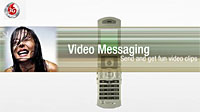 But in-between triumphant licks of triple-thick Cornish clotted cream, Sarin sounded a cautious note, warning that competition was rising.
But in-between triumphant licks of triple-thick Cornish clotted cream, Sarin sounded a cautious note, warning that competition was rising.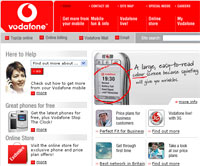 Vodafone performed particularly well in strong markets such as the US and Spain, with revenues growing at more than 20% year on year.
Vodafone performed particularly well in strong markets such as the US and Spain, with revenues growing at more than 20% year on year.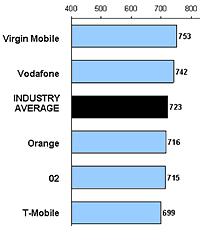 Orange has triumphed in a study rating customer satisfaction among mobile phone contract providers, with Virgin Mobile coming in top in the pre-pay sector, according to the 2005 UK Mobile Telephone Customer Satisfaction Study, run by J.D. Power and Associates.
Orange has triumphed in a study rating customer satisfaction among mobile phone contract providers, with Virgin Mobile coming in top in the pre-pay sector, according to the 2005 UK Mobile Telephone Customer Satisfaction Study, run by J.D. Power and Associates. The authors of the study claim that the results reflect the positive impact of increasing competition and lower tariffs.
The authors of the study claim that the results reflect the positive impact of increasing competition and lower tariffs. The contract segment seemed a well-chuffed bunch too, with satisfaction levels rising to 733 index points from 720 index points in 2004.
The contract segment seemed a well-chuffed bunch too, with satisfaction levels rising to 733 index points from 720 index points in 2004.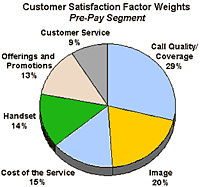 Mobile technology and photo messaging is still a hot potato, with 35 percent of all mobile owners snapping on camera phones and 21 percent sending photos from their mobiles.
Mobile technology and photo messaging is still a hot potato, with 35 percent of all mobile owners snapping on camera phones and 21 percent sending photos from their mobiles. Like the spotty geek who turns up in the pub with a stunner on his arm, Bluetooth has confounded critics by reaching the significant milestone of five million Bluetooth units shipping per week.
Like the spotty geek who turns up in the pub with a stunner on his arm, Bluetooth has confounded critics by reaching the significant milestone of five million Bluetooth units shipping per week.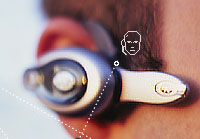 “When you couple that with the recently announced collaboration between the Bluetooth SIG and UWB,” Foley continued, “Bluetooth technology will further reinforce its leading position far into the future. Even today, we expect this will have a positive impact in Bluetooth uptake.”
“When you couple that with the recently announced collaboration between the Bluetooth SIG and UWB,” Foley continued, “Bluetooth technology will further reinforce its leading position far into the future. Even today, we expect this will have a positive impact in Bluetooth uptake.” Seizing a convenient opportunity to squeeze in a bit of PR, Rosenberg added, “Already today, Nokia has introduced state-of-the-art mobile devices that allow data transmission using both high- speed cellular networks, WLAN hot spot access, and Bluetooth technology.”
Seizing a convenient opportunity to squeeze in a bit of PR, Rosenberg added, “Already today, Nokia has introduced state-of-the-art mobile devices that allow data transmission using both high- speed cellular networks, WLAN hot spot access, and Bluetooth technology.”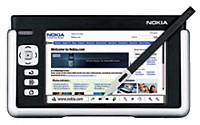 Nokia has surprised pundits at the LinuxWorld Summit in New York by announcing their new Nokia 770 Internet Tablet, a handheld Wi-Fi device for accessing the Internet around the home over a wireless broadband connection.
Nokia has surprised pundits at the LinuxWorld Summit in New York by announcing their new Nokia 770 Internet Tablet, a handheld Wi-Fi device for accessing the Internet around the home over a wireless broadband connection.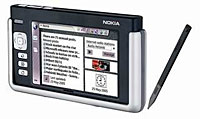 The included 1500mAh battery should keep going for about 3 hours of browsing or 7 days of standby time.
The included 1500mAh battery should keep going for about 3 hours of browsing or 7 days of standby time.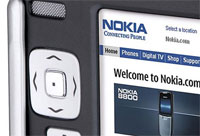 Unlike some teensy-weensy mobile displays, Nokia’s sizeable 800×480 pixel screen should make browsing the web and interacting with email a reasonably practical proposition.
Unlike some teensy-weensy mobile displays, Nokia’s sizeable 800×480 pixel screen should make browsing the web and interacting with email a reasonably practical proposition.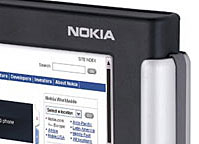 Naturally, there’s an orgy of acronyms detailing the zillion and one audio and video formats that the unit supports (deep breath): MP3, Real Audio, MPEG4, AAC, WAV, AMP, MP2 audio support, with MPEG1, MPEG4, Real Video, H263, AVI, 3GP video support and a slew of common graphics formats supported, including Animated GIF JPEG, BMP, GIF, TIFF, PNG and SVG-Tiny. Phew!
Naturally, there’s an orgy of acronyms detailing the zillion and one audio and video formats that the unit supports (deep breath): MP3, Real Audio, MPEG4, AAC, WAV, AMP, MP2 audio support, with MPEG1, MPEG4, Real Video, H263, AVI, 3GP video support and a slew of common graphics formats supported, including Animated GIF JPEG, BMP, GIF, TIFF, PNG and SVG-Tiny. Phew!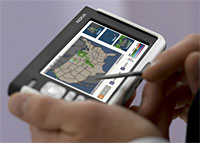 “Linux is a logical choice for the Nokia 770 Internet Tablet as Linux and the Open Source development platform provide us with fast and efficient solutions to build products for this new Nokia product category,” added Janne Jormalainen.
“Linux is a logical choice for the Nokia 770 Internet Tablet as Linux and the Open Source development platform provide us with fast and efficient solutions to build products for this new Nokia product category,” added Janne Jormalainen.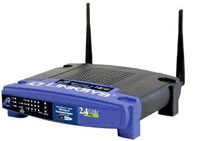 Despite prices being pushed downwards by fierce price competition, worldwide wireless LAN equipment revenue rose 20% to US$767.6 million (~£420m ~€610m) between the fourth quarter of 2004 and the first quarter of 2005.
Despite prices being pushed downwards by fierce price competition, worldwide wireless LAN equipment revenue rose 20% to US$767.6 million (~£420m ~€610m) between the fourth quarter of 2004 and the first quarter of 2005. That’s a thumping great 37% increase in unit shipments, representing not-to-be-scoffed-at sales of 6 million.
That’s a thumping great 37% increase in unit shipments, representing not-to-be-scoffed-at sales of 6 million.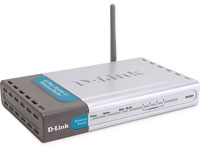 D-Link barged ahead of Cisco-Linksys to grab second place, with NETGEAR in fourth position.
D-Link barged ahead of Cisco-Linksys to grab second place, with NETGEAR in fourth position.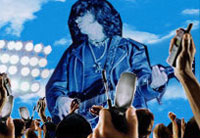 Back in the old days when Glastonbury was a field of medieval mud occupied by confused hippies and LSD travellers, the customary way to show your appreciation of the band was to flash the occasional peace sign or waft a spliff skywards.
Back in the old days when Glastonbury was a field of medieval mud occupied by confused hippies and LSD travellers, the customary way to show your appreciation of the band was to flash the occasional peace sign or waft a spliff skywards. For today’s hi-tech toy generation, new ways of bigging up a band have developed.
For today’s hi-tech toy generation, new ways of bigging up a band have developed. We’re not sure what the remaining 90% of the crowd thought of this pointless onscreen nonsense, but we’d be reaching for our phone zappers in double quick time.
We’re not sure what the remaining 90% of the crowd thought of this pointless onscreen nonsense, but we’d be reaching for our phone zappers in double quick time. Time Warner is considering “spinning off” its AOL division to help finance acquisitions in the future, said chief executive Richard D. Parsons on Friday.
Time Warner is considering “spinning off” its AOL division to help finance acquisitions in the future, said chief executive Richard D. Parsons on Friday.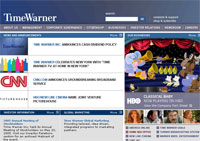 With Time Warner’s pockets already considerably lightened, transatlantic regulators then accused them of overstating advertising and subscriber numbers from mid-2000, with the company settling all charges with thumping great payments of US$510 million (~£279m ~€406.6m) in the States and US$300m (~£164~€239m) in the EU.
With Time Warner’s pockets already considerably lightened, transatlantic regulators then accused them of overstating advertising and subscriber numbers from mid-2000, with the company settling all charges with thumping great payments of US$510 million (~£279m ~€406.6m) in the States and US$300m (~£164~€239m) in the EU. AOL is now trying to find new revenue sources to compensate for the loss of U.S. subscribers to its dial-up Web access service, which has declined by 5 million users in three years, to 21.7 million.
AOL is now trying to find new revenue sources to compensate for the loss of U.S. subscribers to its dial-up Web access service, which has declined by 5 million users in three years, to 21.7 million.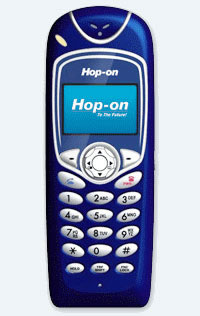 They’ve got a bit of a reputation for being a tad over-affirmative with their announcements, but Californian wireless solutions company Hop-on have revealed details of their new US$39 (~€31~£21.33) WiFi phone.
They’ve got a bit of a reputation for being a tad over-affirmative with their announcements, but Californian wireless solutions company Hop-on have revealed details of their new US$39 (~€31~£21.33) WiFi phone.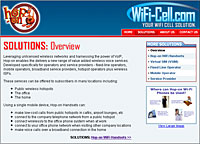 Of course, the main attraction of this phone is the low, low price, with the company claiming that it “provides all the features and functionality of a VoIP terminal adapter but has the advantage of enabling users to talk from any available public or private WiFi access point. ”
Of course, the main attraction of this phone is the low, low price, with the company claiming that it “provides all the features and functionality of a VoIP terminal adapter but has the advantage of enabling users to talk from any available public or private WiFi access point. ”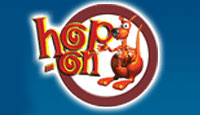 It’s an ugly looking beast all right, but we like the idea of cheap VoIP handsets, although hardened old cynics like us would suggest that you don’t hold your breath on this one, quite yet.
It’s an ugly looking beast all right, but we like the idea of cheap VoIP handsets, although hardened old cynics like us would suggest that you don’t hold your breath on this one, quite yet.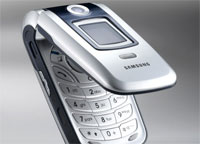 The mobile world domination plans by the white cat-stroking mastermind at Samsung continues apace with the news of yet another new phone from the Korean giants.
The mobile world domination plans by the white cat-stroking mastermind at Samsung continues apace with the news of yet another new phone from the Korean giants.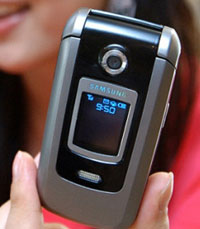 Petite in size yet delivering a surprisingly hefty sonic whack, Samsung’s wee 3G phone incorporates dual stereo speakers for its MP3/AAC/AAC+ audio player, with a healthy 50MB of internal memory for song storage.
Petite in size yet delivering a surprisingly hefty sonic whack, Samsung’s wee 3G phone incorporates dual stereo speakers for its MP3/AAC/AAC+ audio player, with a healthy 50MB of internal memory for song storage.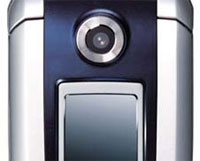 Basic Web browsing is taken care of with a WAP 2.0-enabled micro-browser also present, and the handset offers support for J2ME MIDP 2.0.
Basic Web browsing is taken care of with a WAP 2.0-enabled micro-browser also present, and the handset offers support for J2ME MIDP 2.0.